System Analysis And Design Assignment: Student Enrollment System of ABC University
Question
Task: Prepare a system analysis and design assignment justifying the storage of data in online student enrollment system of ABC University.
Answer
Introductionto the context of system analysis and design assignment
Design specification has been considered as a major part before developing a specific and significant system. In previous assessment different requirement has been gathered on account of the development of the online student enrollment system for ABCU, and for more clarification regarding this document tends to perform data modeling as well as process modeling of the proposed system. However, the main purpose behind the implementation of this system is to enable quick and efficient enrollment management of the students, along with the online transactions of fees as well. Moreover, process and data modeling has been recognized as a step to be performed ahead of its implementation. Firstly, this document will convey the context of this specific system, with its context diagram. Then, it will develop two different levels of data flow diagram as well, and give a clear explanation of each of them. In addition, it will identify each of the entities involved with the system along with their particular and unique relationship with the system's database. Furthermore, it will design the entity-relationship diagram and later also design the physical relational database diagram for the system along with that normalize the ERD. In addition, this report will justify the storage of the data in this particular online student enrollment system of ABC University.
Task 1: Context diagram and documentation
A context diagram is mainly referred as the highest level of showing the Data flow diagram, this is one of the most efficient tools for understanding some details structure of the system which are used for designing some projects, and this tool is useful for business analysts for explaining the whole process(Tilley, 2019). One of the most highlighted features of the context diagram is, it shows the flow of data within the system and external attributes present in the under the diagram. This diagram is mainly represented in a circular shape along with some other employees and clients connected with the main objective of the project.
However, the below-attached image demonstrates the context diagram for the online student enrollment system that tends to be developed by the ABCU. It includes different stakeholders involved with the system, such as the system admin, faculty head, student, and librarians as well. It has briefly explained the flow of data and the purpose of that data flow clearly. For instance, the student will provide data for a different purpose, such in case of sign-up & log-in, or for theenrollment in different courses and exams through the online process, rather for online payment of their fees. Moreover, the system also provides different updates, such as receipt of their payment, different IDs such as enrollment ID, exam ID, and many more details. Furthermore, likewise, the different data flow in between students and the online student enrollment system of the ABC University, the system admin also has some specific connection of data flow with the system, such as the system provides the data of new user's and their payments, and in returns, the system admin manages the entire application along with the new users, and their payments, as well as additionally generates and provide the payment receipts. Moreover, it has demonstrated that the faculty head transacts data with the system regarding the different kinds of enrollment, such as the course enrollment and exam enrollment, and helps to manage it efficiently. Apart from these, the librarians are having also significant purposes in this system, such as it will have the data of the enrolled student in the different courses present in the University, and in returns, it has managed the major responsibility of study material management of the huge amount of students.
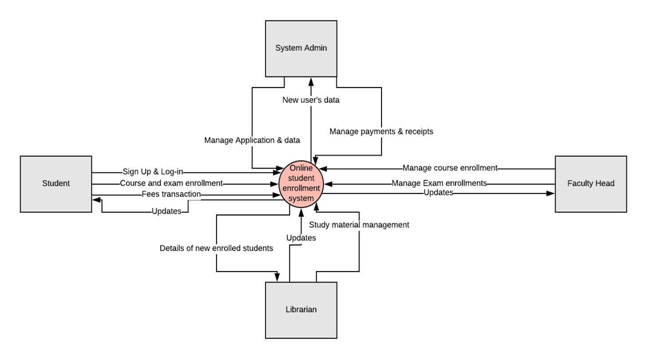
Figure: Context Diagram of the online student enrollment system
(Source: Created by the learner)
Task 2: 0 level data flow diagram and documentation
A 0 level DFD is another term representation of a context diagram; it is basically used for explaining the various kinds of process which are undertaken under by the system, such as some interaction between various external clients who are connected with the system. This is one of the most efficient and easiest ways of understanding how the system would be useful for gaining some profits within various kinds of retail business initiatives. This is mainly under business for explaining various benefits and some functionalities primitives of business within various sectors. Moreover, in the case of the 0 level data flow diagram, this report will include all of the major processes performed within this specific system. All of these processes are having a specific and significant relationship with the efficiency of the online student enrollment system of ABC University. It has demonstrated the process like, managing enrollment of exam, enrollment in course, student's study materials, along with their log-in and sign-up, managing payments as well as managing all students. However, the following image demonstrates the 0 level data flow diagram for the proposed system.
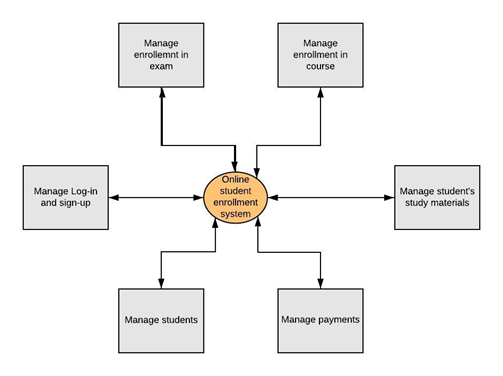
Figure: 0-level DFD of student enrollment system
(Source: Created by the learner)
Task 3: 1 level data flow diagram and documentation
As discussed previous 0 level DFD and context diagram are a pictorial representation of various kinds of data flow within a system under a single diagram. However, a level 1 DFD is basically used for representing various subsections that are used for completing the various processes undertaken within the system. It is also denoted as an elaborated format of context diagram, which shows some concepts of storage of data as well as the flow of data, such as input and output of data within various attributes present under the diagram, and finally, the whole system details are represented under level 1 DFD.
As it has been recognized as the further step of the development of the 0 levels DFD for the online student enrollment system, it will follow the processes of the 0 level DFD. The main purpose behind the development of this specific and significant diagram is to clearly acknowledge an individual process along with its output. However, it only chooses three non-trivial processes from the six processes mentioned in the previous level of 0-level DFD. However, the processes have been elected at this level, is managing the payment, managing the course enrollment, and managing the exam enrollment as well. Furthermore, the following image of 1st level data flow diagram of the online student enrollment system represents all outcomes of each of the processes, mentioned in the above section, formulation of payment ID, student ID, as well as exam ID.
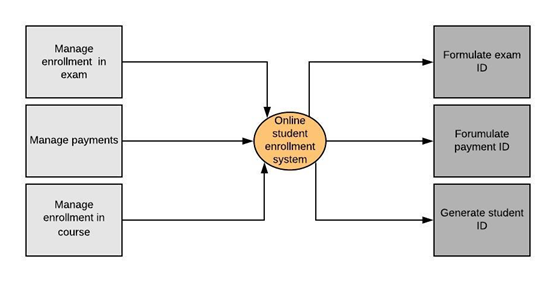
Figure: 1stlevel DFD of student enrollment system
(Source: Created by the learner)
Task 4: i) Specification of entities and their relation
Different entities need to be engaged here in this case for the successful implementation of the system’s database. Proper selection of each of the entities is much necessary for improving the efficiency and accuracy of data storing within the database system(Aguanno& Schibi, 2019). However, the entities that have been elected here to be engaged in this system’s database are listed in the following section of this document:
|
Sl. no. |
Entity |
Relations |
|
I. |
Student |
This has been recognized as one of the major entities of this system, and it has a relation with the system's database for keeping the record of each and every registered student in the university efficiently. |
|
II. |
Course |
This major entity has been engaged in this case for keeping the specific details regarding the course and individual enrollment in a particular course. It will also responsible for recording different data regarding the total seats and available seats of each course. |
|
III. |
Faculty head |
This particular entity has been incorporated here, as there are different courses available in the university and each of the one faculty heads is responsible. So, this specific entity supports for keeping the record of the faculty heads on the basis of each course. |
|
IV. |
Exam |
As the course entity, this specific entity will keep the specific and significant records regarding the enrollment in different exams from the students. |
|
V. |
Librarians |
As like as different faculty heads, there are different librarians are also engaged in the university and the system for managing the supply of study materials to the students of each of the courses, so that, this specific entity will enable the database to store the details regarding the needy librarians as well. |
|
VI. |
Study materials |
On the other hand, this entity has been incorporated for the purpose of managing and storing the data regarding the different study materials of different courses. |
|
VII. |
Payments |
This particular entity will keep records of the numerous payments done in this system by the student regarding their fees for enrolling in different things, such as courses or exams. |
Task 4: ii) Entity-relationship diagram and documentation
Entity Relationship Diagram is full of ERD which is also represented as the ER model; this is mainly a detailed representation of the database design which needs to be implemented under the system(Buede& Miller, 2016). The diagram basically uses various kinds of fundamental symbols and connectors for giving a brief explanation of various kinds of functionalities that the database, such as some internal connections between various the employees and the system. The ERD diagram is generally used for explaining some important business objectives under which various objectives, roles, and relationships of various entities are explained briefly. However, the following image represents each and every entity and its relationships. It has demonstrated entities like a student, faculty head, exam, course, librarians, study material, as well aspayment. Furthermore, it has also represented each of the significant attributes to be utilized for the satisfactory storage of data regarding each of the entities. This diagram will help a lot during the development of the database for storing the significant data transacted in between the users and the system in the system database, accurately and perfectly.
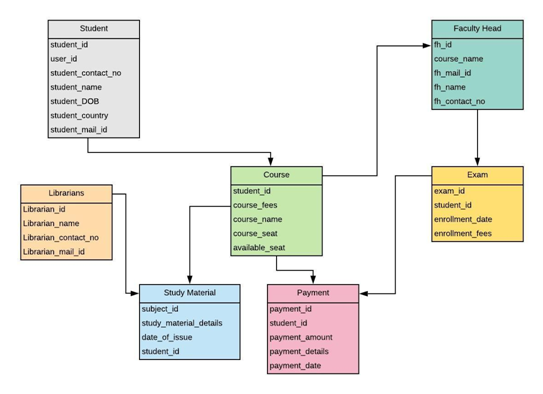
Figure: ERD of student enrollment system
(Source: Created by the learner)
Task 5: Specification of data storage and justification
In the case of an online enrolment system, a Database management system is one of the most efficient and useful methods, it is important in case of various factors such as it helps in managing huge amounts of files and also allows users to undertake multiple tasks within a single database. Such a system would allow in storing a huge amount of information of various students present in the university. It would be useful for the university as it helps in handling various kinds task within a single system, some of the essential information which could be stored within the database are students records which include names, students ID's, records of students, library records, and also the amount of fee paid by every student present in the university. Along with all these the database system also provides the facility of data security, such as the data once stored cannot be misplaced or deleted, thus data security is one of the most important qualities of database systems(Franks& American Library Association, 2018). Apart from all such efficient features database system also avails the facility of data backup and restore, which states that even in case of some kind of emergency if the data is erased, database system would have a backup of entire information stored within the system(Vidhya et al., 2016). Thus, the database management system is a better option as compared to the file system.
A file system consists of certain drawbacks which consist of data redundancy, which means data stored in the system could be misplaced; data inconsistency which stated that the data which is stored within the file system is inconsistent which is similar to data redundancy. Moreover, in some case it becomes quite difficult to access the files which are stored under a file system, as well as the data cannot be shared with others only limited people could access the files. Apart from all these file systems do not provide the facility of data integrity, the file system also holds various kinds of security issues, such as the data stored could be stolen, due to all such drawbacks file system is not useful for making online enrolment system for the university(Dick et al., 2017).
The Database management system provides various kinds of advantages due to which it is considered as the best option for the online enrolment system. One of its most important advantage it provides the facility of improved data sharing, well-advanced data security system, it also includes the facility of better data integration, and it also decreases the probability of data redundancy and data inconsistency, it also provides various advanced options of accessing the data which is stored within the database, allows to make better decision making steps, moreover database system increases some end-user productivity of the enrolment system(Sequeda, 2016). Finally one of the important advantages is database system is cost-efficient and could be easily implemented. Thus database management systems could be approved as an important system for the online enrolment system for the university.
Task 6: Physical relational database and third normal form
Physical database design is mainly used for converting the logical data model into a separate format of SQL statements which are generally used for defining the whole database(Harrington & Harrington, 2016). Moreover, in case of the relational database system, it is quite easy for the system to convert the logical data into the physical database, some of the basic rules for conversion are some basic attributed transforms in the form of the table under physical database, some important connections in between the attributes are connected with foreign keys, space is not allowed under any kind of process, and finally, the table names which are mentioned must match the SQL naming rules. The physical relational database on behalf of the developed ERD has been attached in the following section of the document:
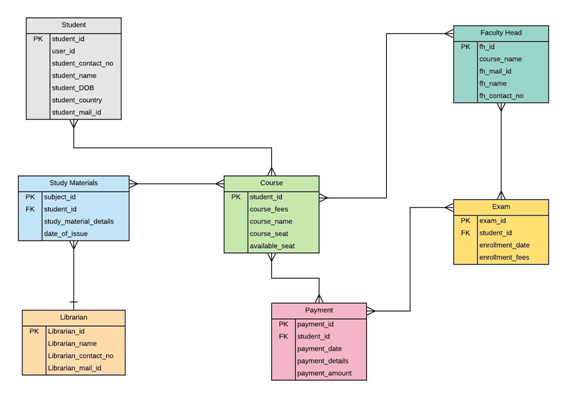
Figure: Physical relational database of student enrollment system
(Source: Created by the learner)
A third normal form is the design of a database system that is used under the relational database for understanding various fundamental principles such that duplicate data could not be inserted into the database. It is also used for decreasing various software bugs and is utilized for simplifying the various process involved in the data management system(O'Brien& Mc Guckin, 2016). A Third normal form must approve certain standards of data relation as most of the process within the system is mainly dependent upon the primary key, thus is denoted as one of the most important functions under the database management system. However, the following section will normalize the ERD developed in the previous task following the rules of the third normal form.
|
Student |
||||||
|
student_id |
user_id |
student_contact_no |
student_name |
student_DOB |
student_country |
student_mail_id |
|
1 |
Rebel@123 |
9090893989 |
Rebel Johnson |
21/05/1996 |
Australia |
|
|
Course enrollment |
||||||
|
student_id |
course_seat |
course_name |
course_fees |
available_seat |
||
|
1 |
100 |
Education |
$30,000 |
23 |
||
|
Faculty Head |
||||||
|
fh_id |
course_name |
fh_mail_id |
fh_name |
fh_contact_no |
||
|
fh1 |
Education |
Love@gmail.com |
John Love |
9090876534 |
||
|
Librarians |
||||||
|
Librarian_id |
Librarian_name |
Librarian_contact_no |
Librarian_mail_id |
|||
|
L1 |
Jhonny Costa |
9029039202 |
Costarock@yahoomail.com |
|||
|
Study Material |
||||||
|
subject_id |
study_material_details |
date_of_issue |
||||
|
EDU-123 |
Edu-chap 1 |
29.07.2020 |
||||
|
Payment |
||||||
|
payment_id |
payment_amount |
payment_date |
payment_details |
|||
|
101 |
$30,000 |
29.07.2020 |
Course enrollment fees |
|||
|
Exam |
||||||
|
exam_id |
enrollment_fees |
enrollment_date |
||||
|
Edu-1 |
$1,000 |
29.07.2020 |
||||
Conclusion
This report includes its over-all discussion about the online student enrollment system of ABC University. This report concludes that by performing the process and data modeling for the specific system, it will make the development work much easy and accurate as well.
References
Aguanno, K., & Schibi, O. (2019). Agile business analysis : enabling continuous improvement of requirements, project scope, and agile project results. J. Ross Publishing. https://public.ebookcentral.proquest.com/choice/publicfullrecord.aspx?p=5762202.
Buede, D. M., & Miller, W. D. (2016). The engineering design of systems : models and method (Third). Wiley. https://lesa.on.worldcat.org/oclc/926050644
Dick, J., Hull, E., & Jackson, K. (2017). Requirements engineering (4th ed.). Springer. https://doi.org/10.1007/978-3-319-61073-3 Franks, P. C., & American Library Association. (2018). Records and information management (Second). System analysis and design assignmentALA Neal-Schuman.https://lesa.on.worldcat.org/oclc/1056246432
Harrington, J. L., & Harrington, J. L. (2016). Relational database design and implementation (Fourth). Morgan Kaufmann/Elsevier. INSERT-MISSING-URL. https://lesa.on.worldcat.org/oclc/947597075
O'Brien, A. M., & Mc Guckin, C. (2016). The systematic literature review method : trials and tribulations of electronic database searching at doctoral level (Ser. Sage research methods. cases). SAGE. https://doi.org/10.4135/978144627305015595381.
Sequeda, J. F. (2016). Integrating relational databases with the semantic web (Ser. Studies on the semantic web, vol. 022). IOS Press. https://lesa.on.worldcat.org/oclc/957490964
Tilley, S. (2019). Systems analysis and design (12th ed.). Cengage. https://public.ebookcentral.proquest.com/choice/publicfullrecord.aspx?p=6039756.
Vidhya, V., Jeyaram, G., & Ishwarya, K. R. (2016). Database management systems. Alpha Science International. https://lesa.on.worldcat.org/oclc/1021806756












